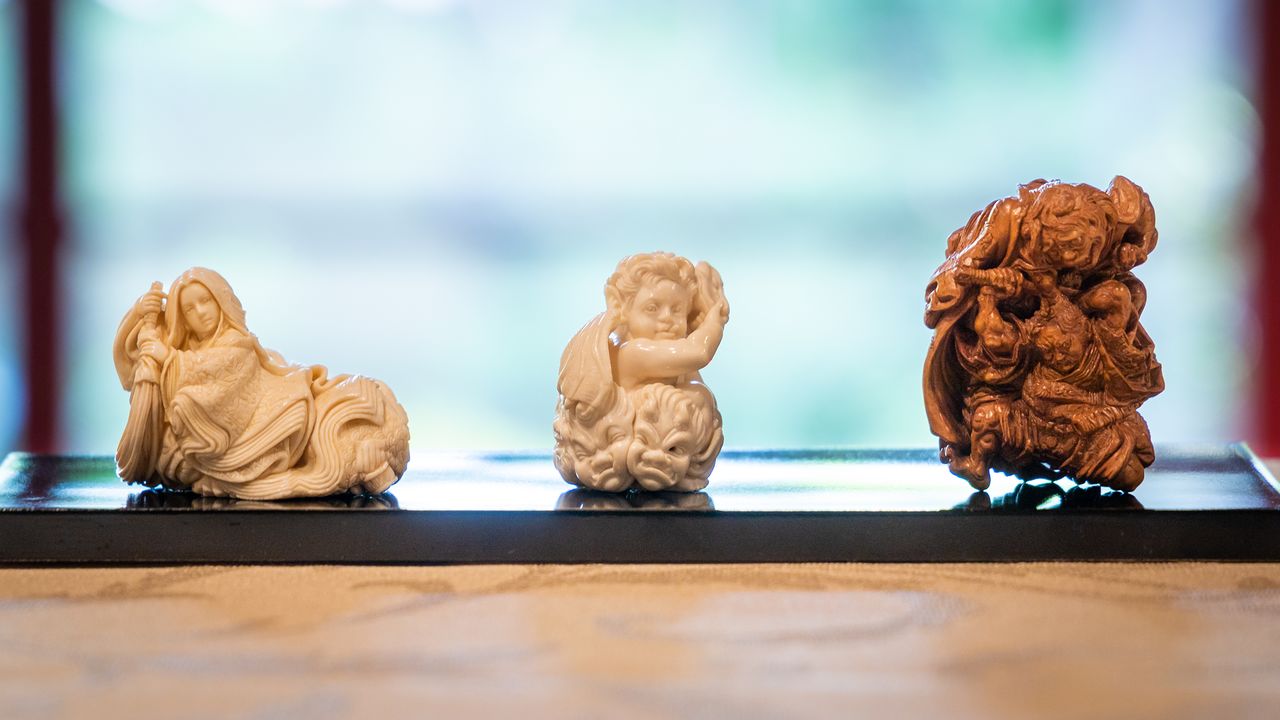
Kyoto Seishū Netsuke Art Museum: A Miniature Kingdom
Guideto Japan
History Travel- English
- 日本語
- 简体字
- 繁體字
- Français
- Español
- العربية
- Русский
Small Universes
Japanese netsuke are elaborately detailed figurines. Measuring around 3–5 centimeters in length, they have been described as “small universes in the palm of the hand” for their intricacy.
Netsuke started out as simple fasteners for attaching personal items like inrō (cases for a seal or medicine), purses, or tobacco pouches to a kimono’s sash. From the eighteenth century, carved and painted varieties became popular among all classes of society. Beginning in the Meiji era (1868–1912), they were exported as artwork, winning devotees overseas.
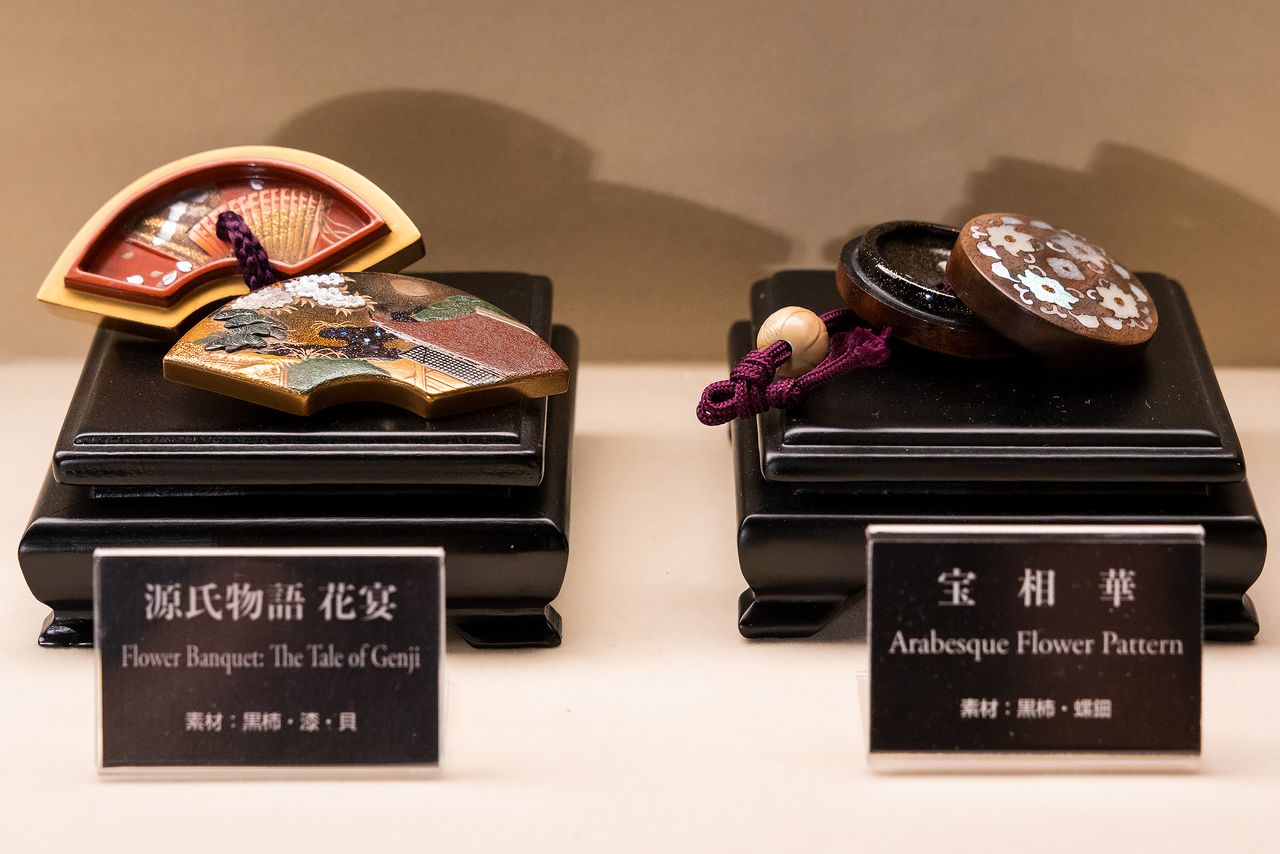
Box netsuke like these are often decorated with lacquer work or mother-of-pearl.
There are now many extensive collections of netsuke outside of Japan, some containing pieces that have sold for tens of millions of yen at overseas auctions. Japan still has more than a hundred artisans specializing in creating netsuke, but the artworks are relatively underappreciated in their home country.
In 2007, Kyoto Seishū Netsuke Art Museum opened to preserve and exhibit Japan’s traditional netsuke craftsmanship. Housed in a converted samurai residence in Mibu, Kyoto, the museum is the only such facility dedicated to these miniatures. It boasts a collection of over 6,000 works, with around 400 on display at one time.
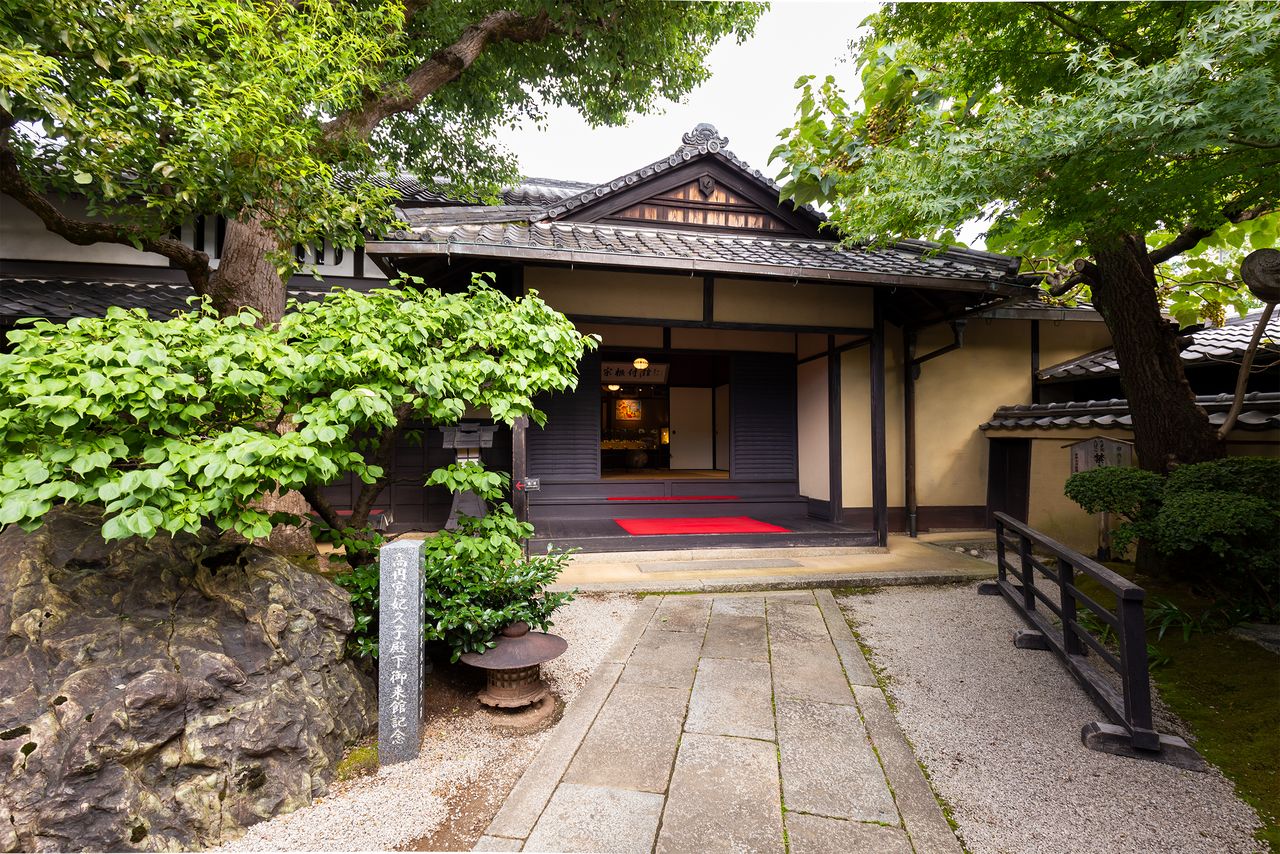
The museum is in a former samurai residence. Outside the entrance, a monument commemorates a visit by Princess Hisako, the widow of a cousin of Emperor Emeritus Akihito and a noted netsuke collector.
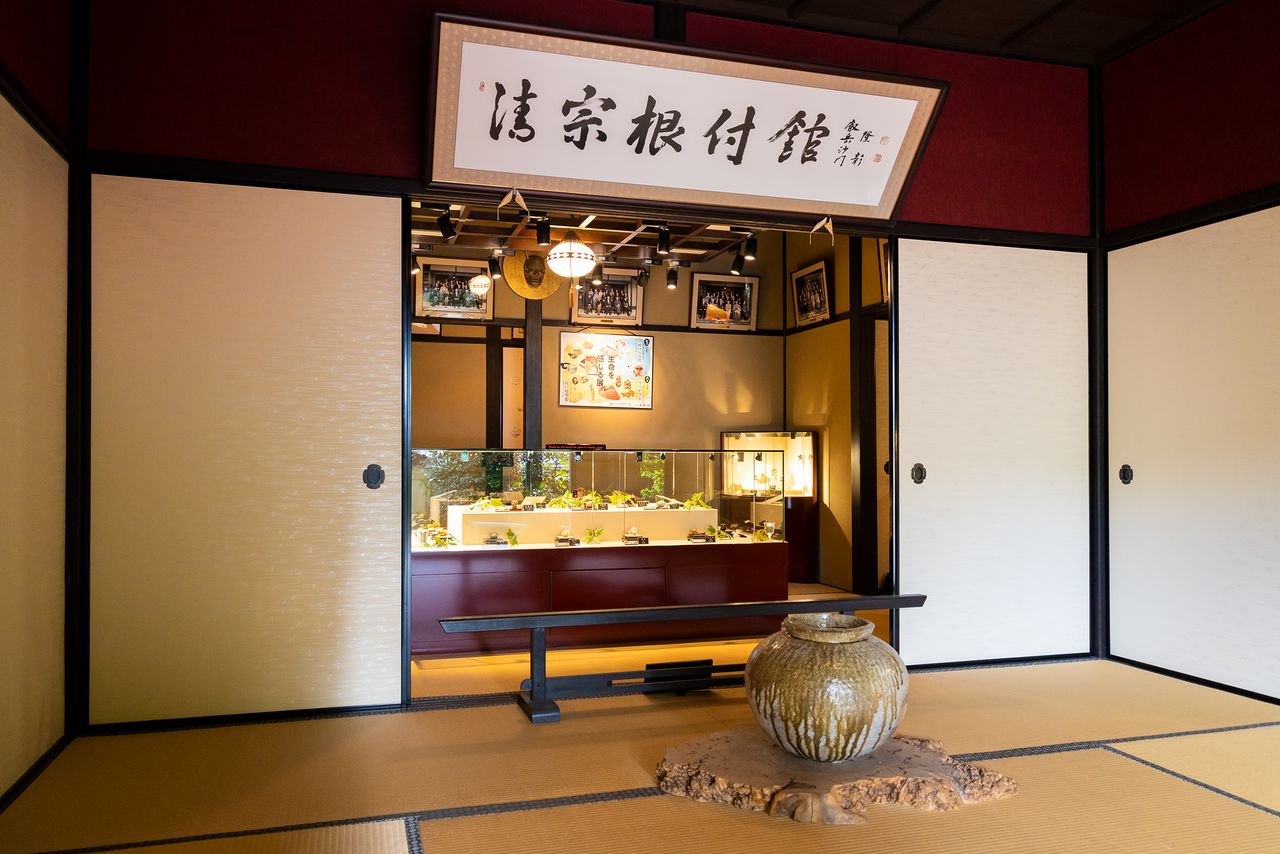
The traditional interior of the museum gives a sense of having traveled back in time.
The museum’s chief curator, Date Atsushi, says that netsuke have fans and collectors around the globe, noting that “sometimes Japanese visitors even say they were introduced to them by their foreign friends.” Although netsuke today are mostly appreciated for their beauty, Date says that they are still practical for carrying items like wallets or smartphones, which he points out can get in the way when a person sits down. He uses a netsuke himself for his wallet, but notes with a laugh that losing such a precious piece of art might come as a greater shock than the article it is attached to.
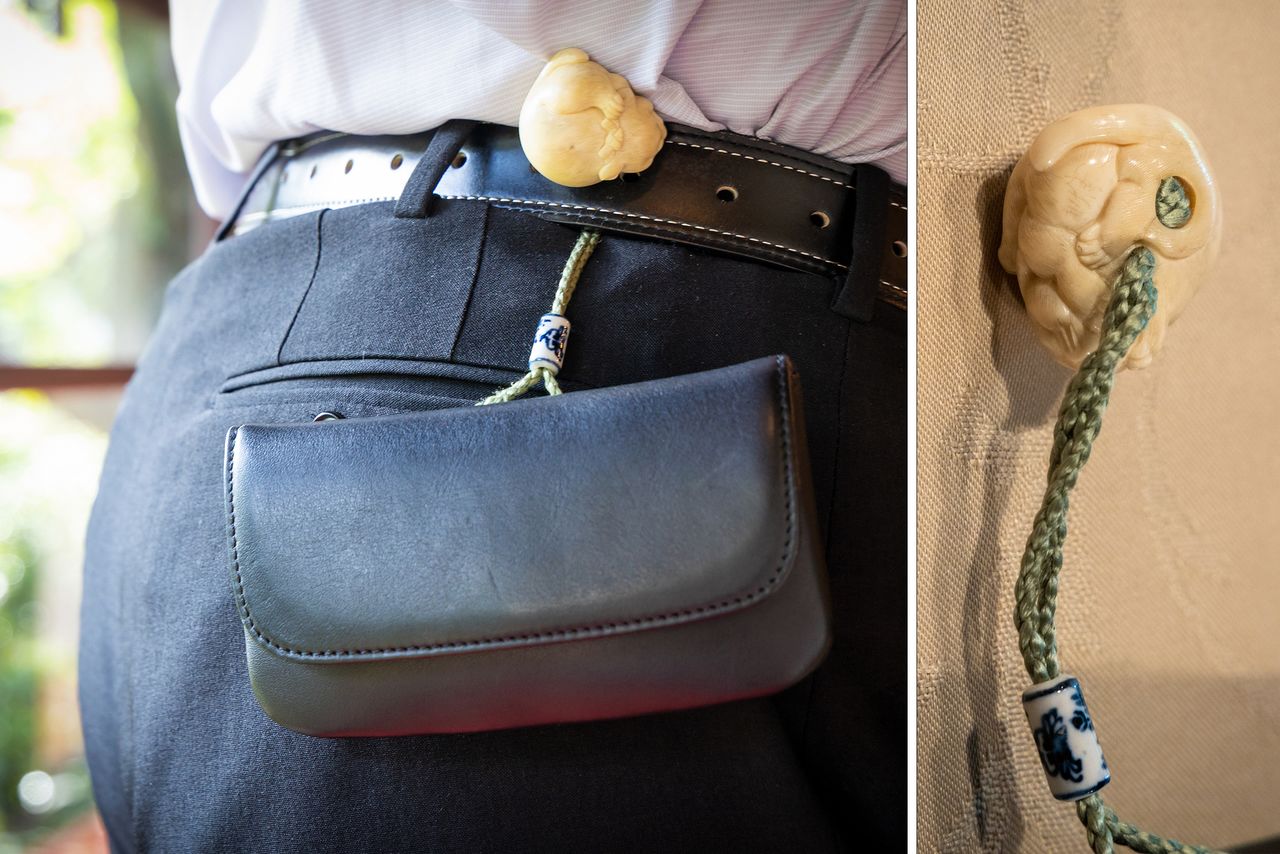
Date carries his wallet using a netsuke shaped like a curled-up cat. The miniatures always have holes on their back for passing a cord through.
Samurai Accessory
Date says that the first netsuke were fasteners shaped like rings or circles and are thought to have come from Kyoto. In the late sixteenth century, when regional daimyō fought for supremacy over a divided state, the fasteners appear in pictures of street scenes in the capital.
At this time, there was a change in fashions that saw rising popularity for the kosode, a forerunner to the kimono with narrow sleeve openings, fastened with a thin obi. Instead of holding personal objects in their sleeves, as with the predecessor of the kosode, people started hanging necessary items from the garment’s sash. Pioneers of this fashion included flashy, low-ranking samurai called kabukimono, and newly rich dilettante merchants.
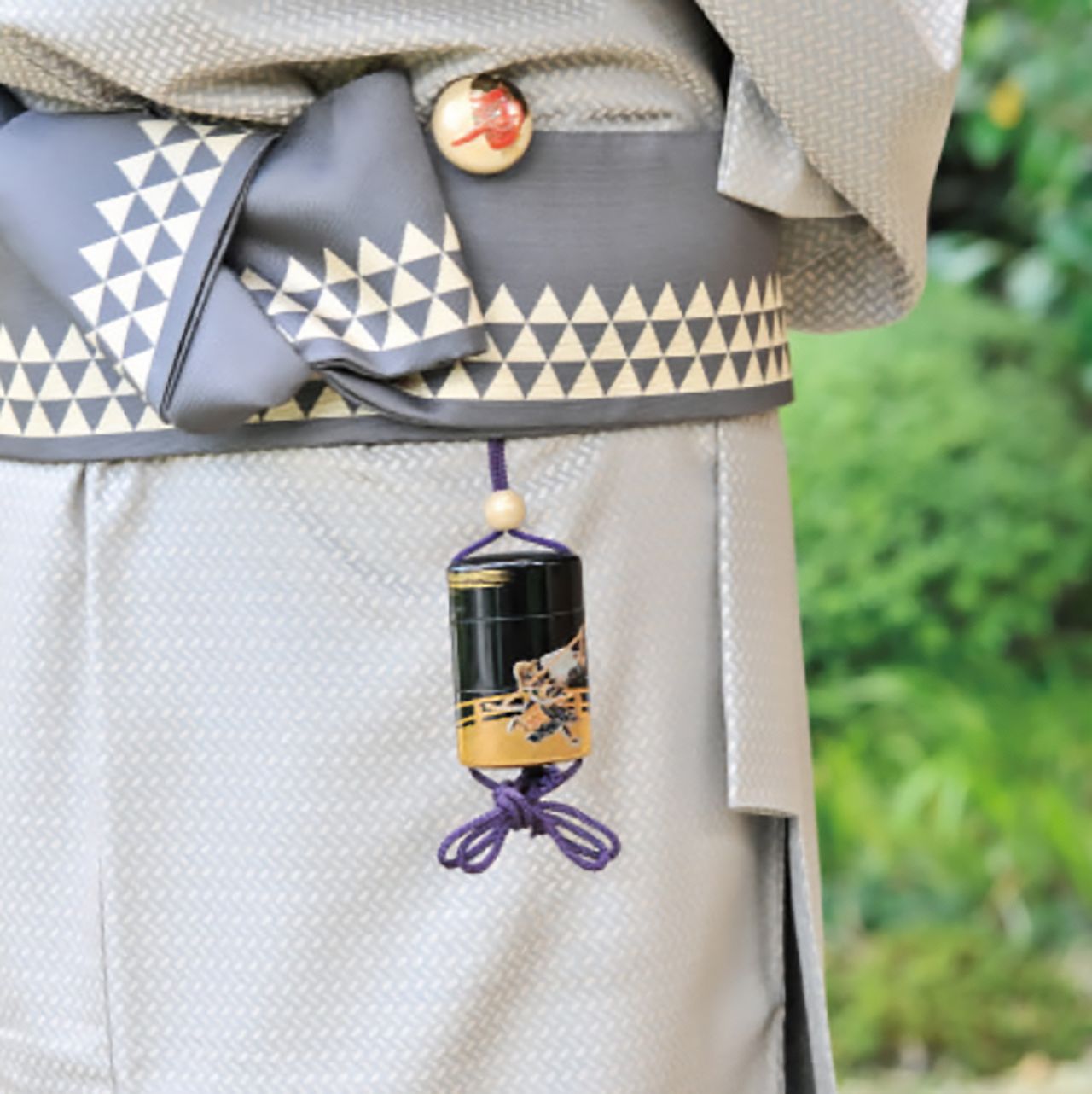
An inrō container hangs from a kimono obi, attached to a round manjū netsuke. (Courtesy Kyoto Seishū Netsuke Art Museum)
Entering the Edo period, the fasteners became standard samurai accessories. Their convenience and decorative qualities meant they were used to hang all kinds of items. They were taken up enthusiastically by the common people around the Genroku era (1688–1704), becoming part of everyday attire. It was around this time that they started being known as netsuke.
While many were originally practical and basic in design, a rise in demand led to more specialist artisans trying their hands at netsuke, such as Buddhist art sculptors, mask makers, and metal engravers. Materials ranged from boxwood and ebony to deer horn and ivory, with designs including decorative elements like colors, makie lacquer work, inlay, or mother-of-pearl.
The nineteenth century saw a boom in the popularity of netsuke. The number of serious collectors increased, and some wealthy merchants even employed their own personal artisans. Date explains: “Just as samurai showed off their swords while drinking together, townspeople tried to outdo each other through their stylish netsuke.”
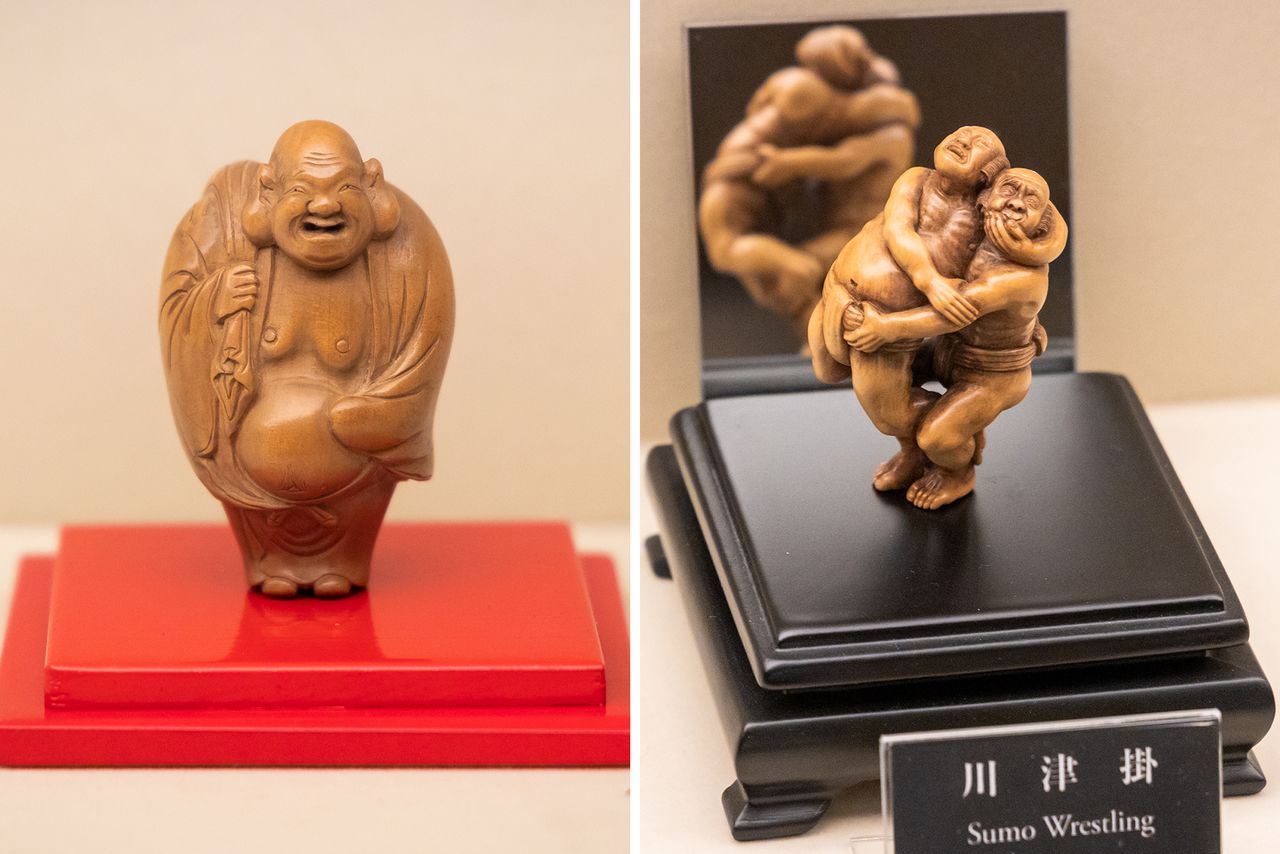
Many classic netsuke are on display, such as the figure of Hotei (left), one of the seven gods of fortune. On the right is a contemporary work, also in wood, depicting sumō wrestlers.
Cultural Legacy
The widespread adoption of Western clothing in the Meiji era brought a lull in domestic fortunes for netsuke. At the same time, they won appreciation as artworks in the West, and netsuke makers began producing items for export. This encouraged greater creative freedom and further artistic refinement, but it meant many masterpieces left Japan, including those from the Edo period.
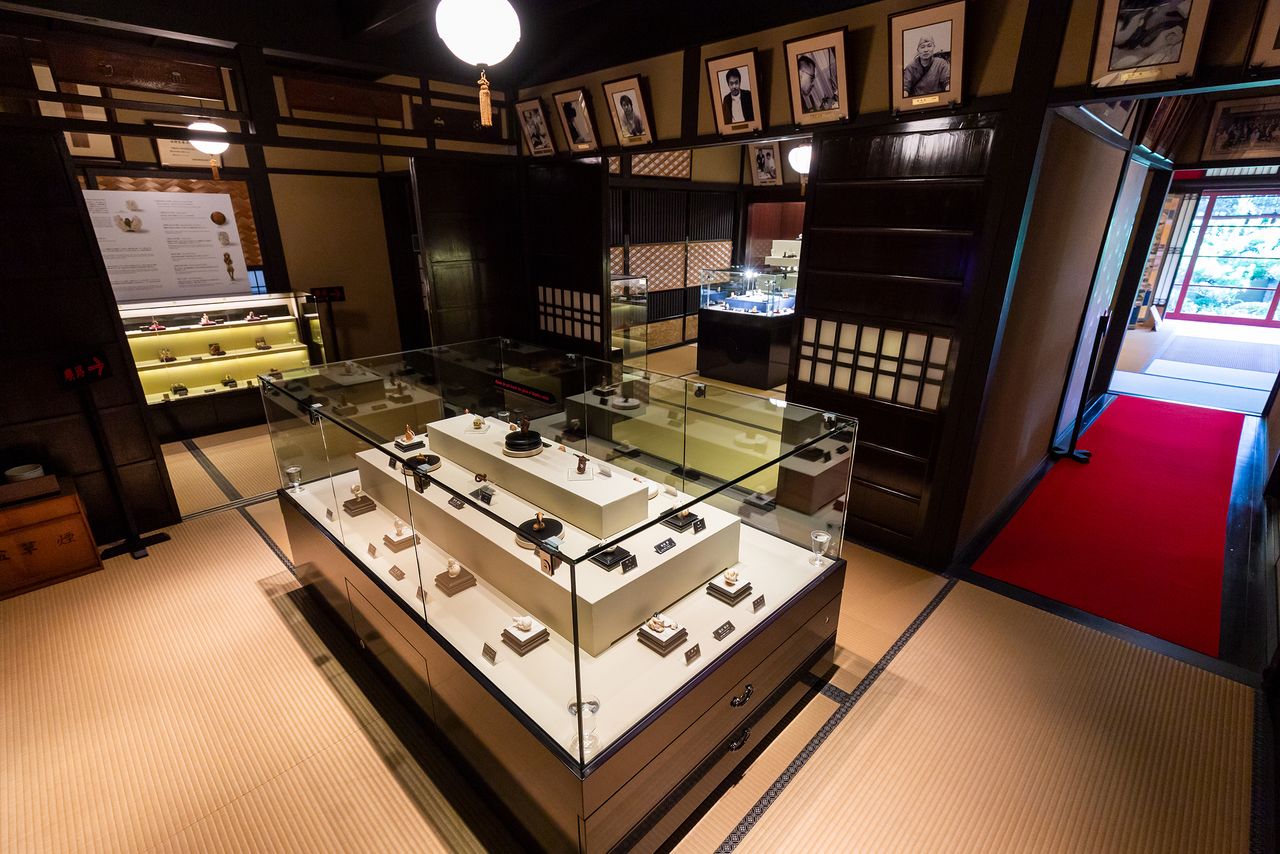
The museum’s exhibition rooms are attractively laid out.
While Date says he is happy to see global recognition for the country’s traditional crafts, he laments that it has also resulted in limited opportunities to see first-class artworks in Japan. “This is a problem for passing down the cultural legacy and training new artisans,” he explains. Netsuke are mainly bought by individual collectors, and they are rarely displayed in art galleries or museums. If exported, the artworks are often never seen again even by their creators themselves.
This makes the museum a priceless resource for preserving craftsmanship. Netsuke artists regularly visit the museum to observe high-quality works, take inspiration, or hone their techniques. Those who have works on display are able to look back on their past creations and often reach out to the facility with new masterpieces they wish to add to the collection.
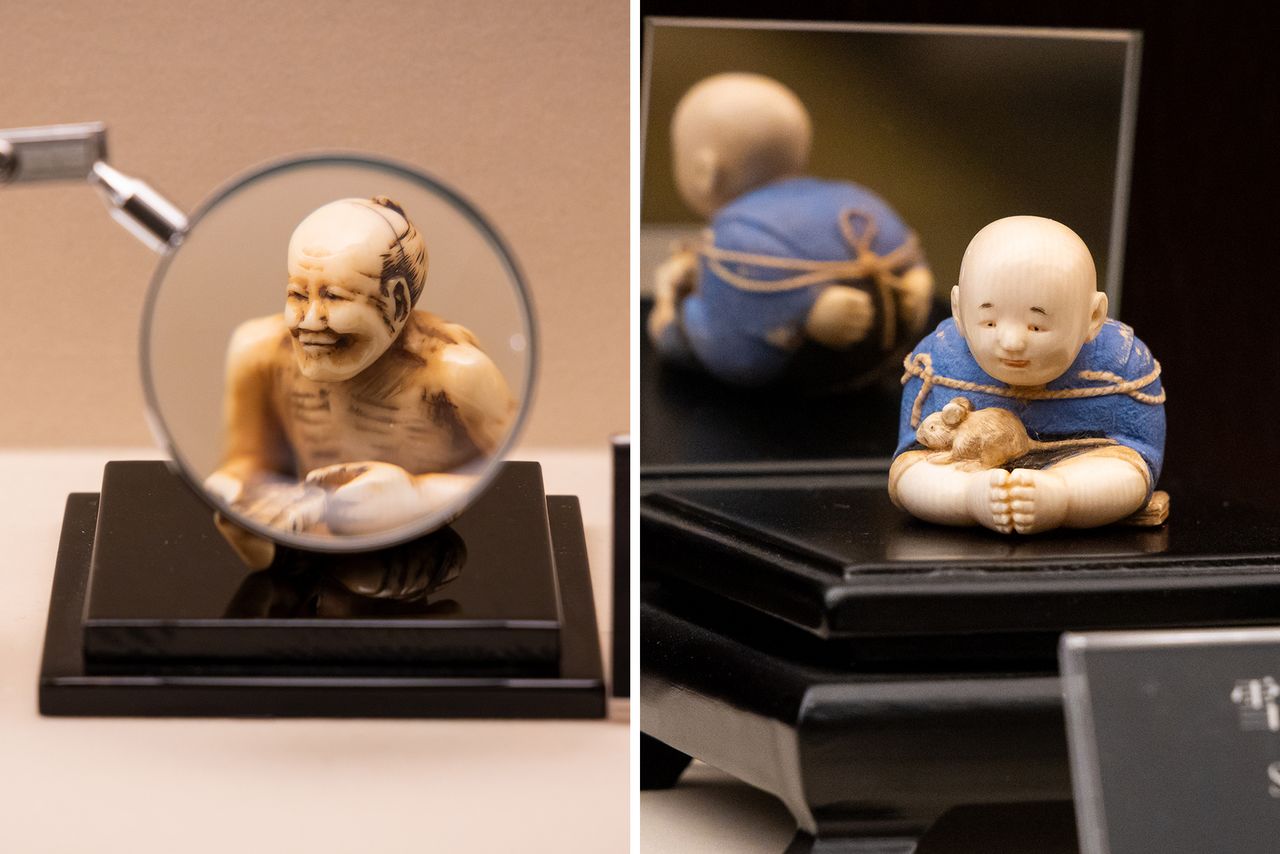
On the left is a weaver of waraji or straw sandals, while the netsuke on the right depicts an episode from the youth of the monk and painter Sesshū (1420–1506). Exhibits often have magnifying glasses for enlarging fine details or mirrors for seeing the backs of the artworks.
Different Forms
Over the years, creators developed many distinct forms for netsuke. The most practical is the manjū netsuke. Shaped like the steamed bun they are named after, they are decorated with makie or relief work and have holes on the underside for attaching a cord.
The ryūsa netsuke is an advanced version of the manjū, named after the craftsman said to have developed it. The interior is extensively cut away, and this kind of openwork requires a great deal of skill.
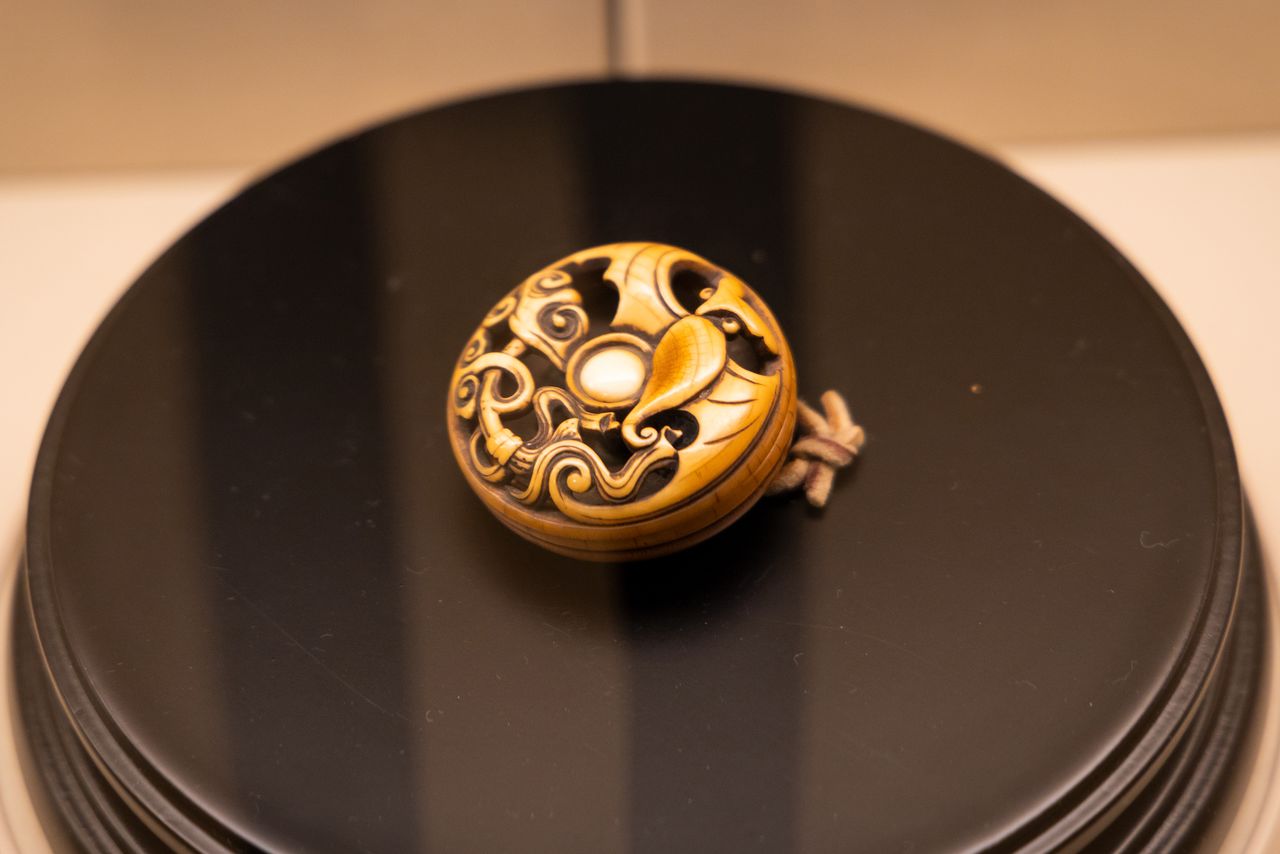
A ryūsa netsuke shaped like a snail. Between the minute decorations, the interior is hollowed out.
The most popular form is the katabori netsuke, which is a three-dimensional figure or object. Often these are in the form of people or animals in myths, stories, or kabuki plays. They may represent the owner’s hobbies or beliefs, act as amulets, or show seasonal items like fruits, nuts, or berries. In a similar form, the men netsuke might depict nō masks or the faces of the seven gods of fortune.
Also common are fasteners with lids for carrying pills and coins, known as hako (box) or kagamibuta (mirror lid) netsuke.
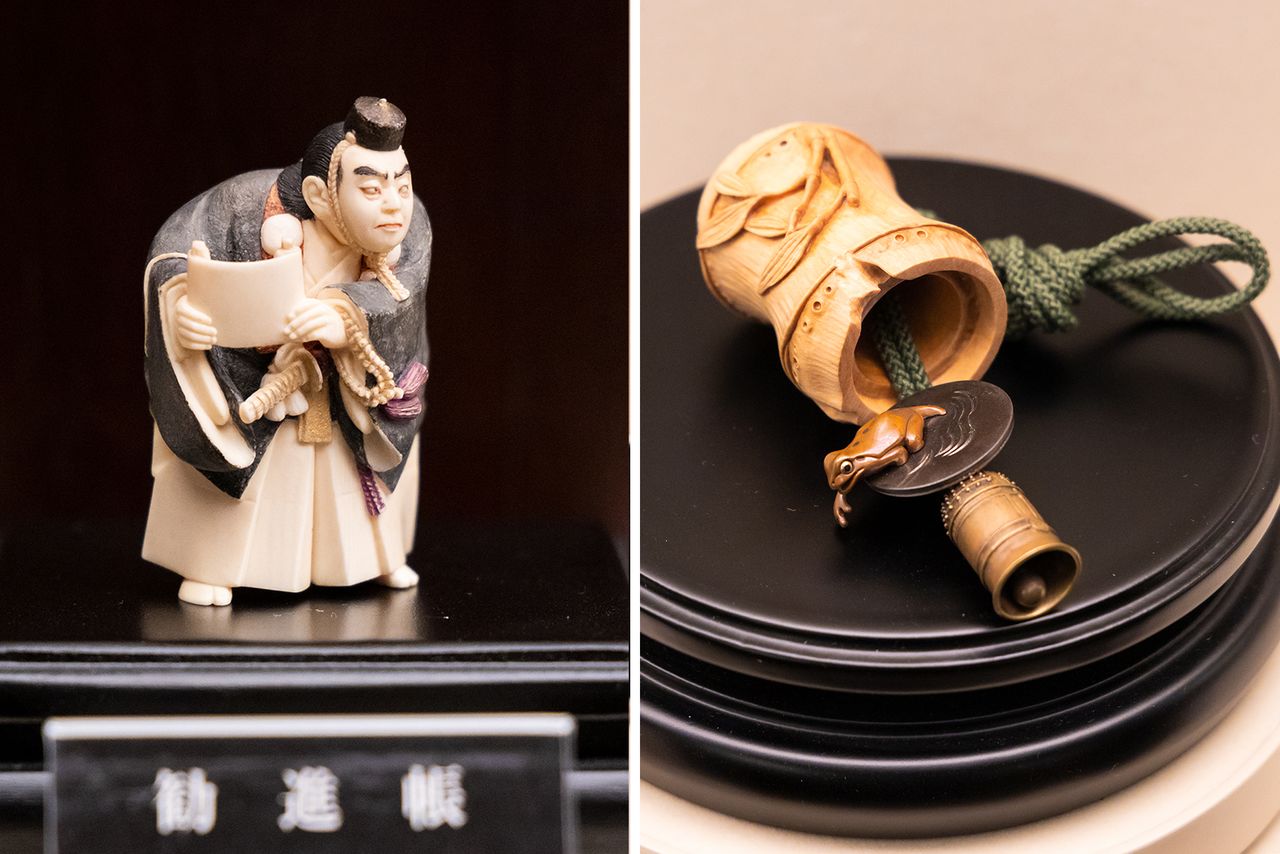
The netsuke on the left shows a scene from the popular kabuki play Kanjinchō. On the right is a kagamibuta in which a frog is part of the lid.
Encouraging Emerging Artists
Netsuke artisans use around 50 kinds of knives to carve intricate designs on objects a few centimeters in length. Maintaining the high level of concentration that is necessary is difficult over long periods, so typically only a few hours each day are devoted to carving. Along with polishing, coloring, and other tasks, carried out in parallel, it takes several months to complete a single work.
The museum holds a competition, the Golden Netsuke Award, each year to encourage emerging artists. Princess Hisako, one of Japan’s foremost collectors, attends as a guest of honor, drawing media attention and helping to spread the word about the miniatures.
The Mibu area, where the museum is located, is also noted for its association with the Shinsengumi, a force of Tokugawa loyalists that fought unsuccessfully to stop the fall of the shogunate. The nearby temple Mibudera was a Shinsengumi headquarters.
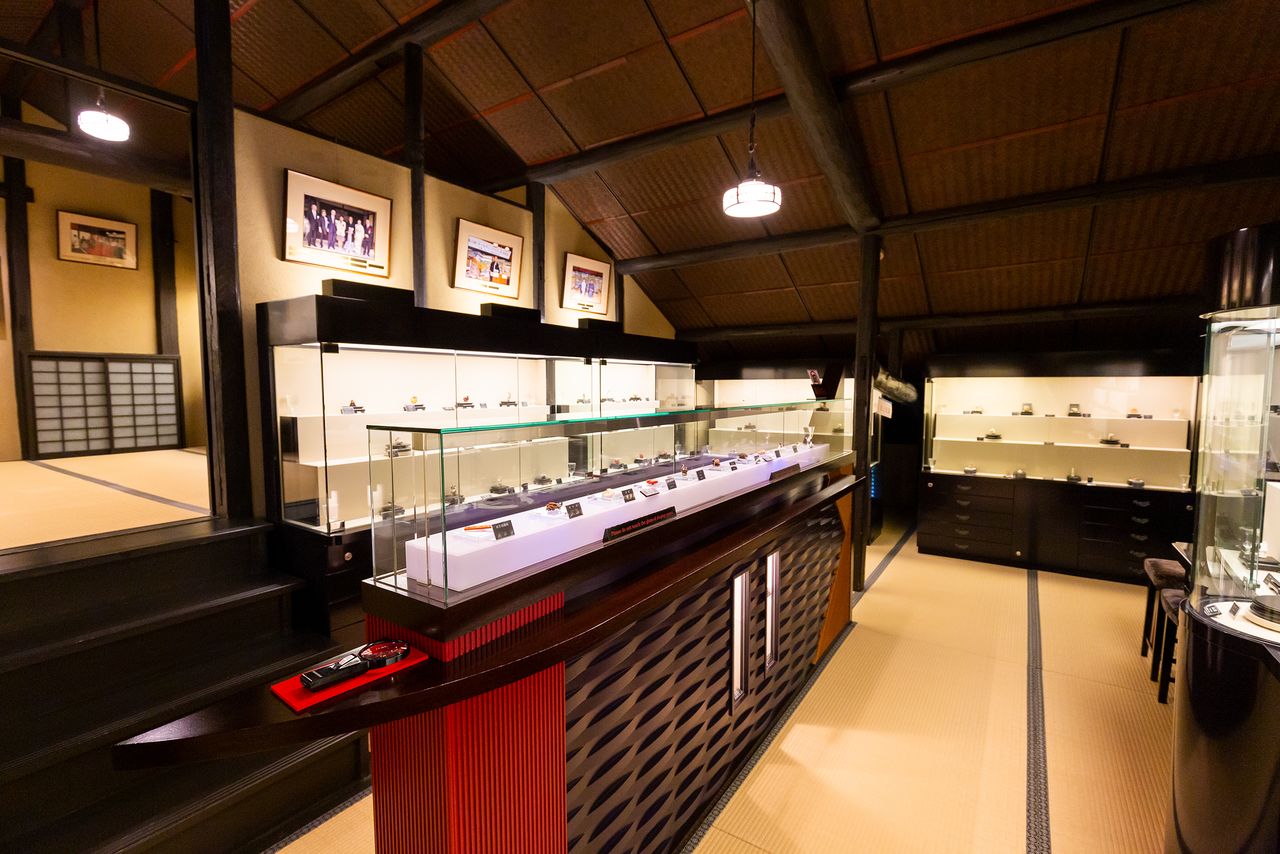
Photographs of Golden Netsuke Award ceremonies are displayed on the walls of the second floor.
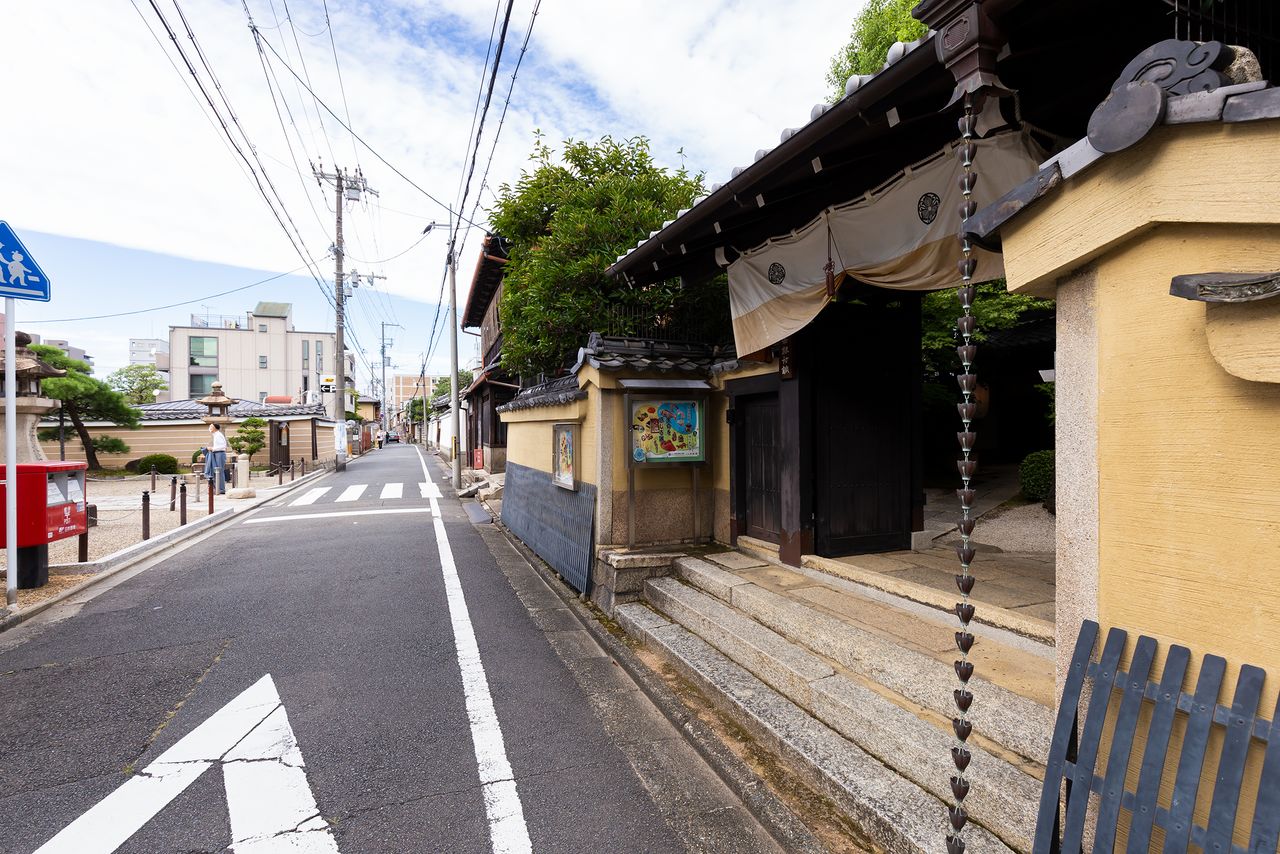
The Mibudera temple gate is near the red post box in this picture, almost opposite the entrance to the museum.
Kyoto Seishū Netsuke Art Museum
- Address: 46-1 Mibu Kayōgoshochō, Nakagyō, Kyoto
- Hours: 10:00 am to 5:00 pm (last entrance at 4:30 pm)
- Closed Mondays (or Tuesday when Monday is a national holiday), August 13 to 16, and December 29 to January 5
- Admission: ¥1,000 standard; ¥500 for elementary to high school students
- Access: 10-minute walk from Ōmiya Station or Shijō Ōmiya Station; 2-minute walk from Mibuderamichi bus stop.
(Originally published in Japanese. Interviews, text, and photographs by Nippon.com. Banner photo: The netsuke Fujitsubo, a character from The Tale of Genji, Nanatsumen, satirizing contemporary society, and Watanabe no Tsuna, inspired by an ukiyo-e about the legendary oni killer.)